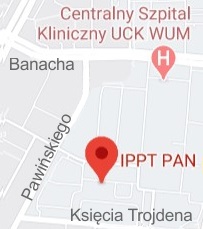| Bartłomiej Błachowski, PhD, DSc |

|
|
Doctoral thesis
| 2005 | Optymalne sterowanie drganiami masztów z odciągami
|
| 2020-06-04 | Identyfikacja uszkodzeń elementów konstrukcyjnych i połączeń śrubowych w przestrzennych konstrukcjach prętowych |
| 1. | 2025-06-27 | Ostrowski Mariusz  |
Semi-active control of energy transfer between vibration modes in mechanical structures |
Recent publications
| 1. |
Świercz A., Błachowski B. D., Olaszek P.♦, Holnicki-Szulc J. K., Jankowski Ł., Computationally efficient multi-type sensor placement for large-scale engineering structures,
MECHANICAL SYSTEMS AND SIGNAL PROCESSING, ISSN: 0888-3270, DOI: 10.1016/j.ymssp.2025.112615, Vol.230, pp.112615-1-112615-21, 2025 Abstract: Keywords:
| |||||||||||||||||||||||||
| 2. |
Tauzowski P., Ostrowski M., Bogucki D., Jarosik P., Błachowski B., Structural Component Identification and Damage Localization of Civil Infrastructure Using Semantic Segmentation,
SENSORS, ISSN: 1424-8220, DOI: 10.3390/s25154698, Vol.25, No.15, pp.4698--, 2025 Abstract: Keywords:
| |||||||||||||||||||||||||
| 3. |
Tauzowski P., Błachowski B.D., Zawidzka E., Zawidzki M., MorphoGen: Topology optimization software for Extremely Modular Systems,
SoftwareX, ISSN: 2352-7110, DOI: 10.1016/j.softx.2024.101797, Vol.27, pp.1-10, 2024 Abstract: Keywords:
| |||||||||||||||||||||||||
| 4. |
Tauzowski P., Błachowski B., Lógó J.♦, Computational framework for a family of methods based on stress-constrained topology optimization,
COMPUTERS AND STRUCTURES, ISSN: 0045-7949, DOI: 10.1016/j.compstruc.2024.107493, Vol.303, pp.1-14, 2024 Abstract: Keywords:
| |||||||||||||||||||||||||
| 5. |
Tauzowski P., Błachowski B., Lógó J.♦, Optimal topologies considering fatigue with reliability constraint,
Advances in Engineering Software, ISSN: 0965-9978, DOI: 10.1016/j.advengsoft.2023.103590, Vol.189, pp.1-12, 2024 Abstract: Keywords:
| |||||||||||||||||||||||||
| 6. |
Ostrowski M., Mikułkowski G., Błachowski B., Jankowski Ł., Experimental assessment of Bayesian and mode matching approaches for parametric identification of bolted connections,
MECHANICAL SYSTEMS AND SIGNAL PROCESSING, ISSN: 0888-3270, DOI: 10.1016/j.ymssp.2023.110652, Vol.201, pp.110652-110652, 2023 Abstract: Keywords:
| |||||||||||||||||||||||||
| 7. |
Ostrowski M., Błachowski B., Mikułowski G., Jankowski Ł., Influence of Noise in Computer-Vision-Based Measurements on Parameter Identification in Structural Dynamics,
SENSORS, ISSN: 1424-8220, DOI: 10.3390/s23010291, Vol.23, No.1, pp.1-27, 2023 Abstract: Keywords:
| |||||||||||||||||||||||||
| 8. |
Ostrowski M., Jedlińska A., Popławski B., Błachowski B., Mikułowski G., Pisarski D., Jankowski , Sliding Mode Control for Semi-Active Damping of Vibrations Using On/Off Viscous Structural Nodes,
Buildings, ISSN: 2075-5309, DOI: 10.3390/buildings13020348, Vol.13, No.2, pp.1-16, 2023 Abstract: Keywords:
| |||||||||||||||||||||||||
| 9. |
Ostrowski M., Błachowski B., Wójcik B.♦, Żarski M.♦, Tauzowski P., Jankowski Ł., A framework for computer vision-based health monitoring of a truss structure subjected to unknown excitations,
Earthquake Engineering and Engineering Vibration, ISSN: 1993-503X, DOI: 10.1007/s11803-023-2154-3, pp.1-17, 2023 Abstract: Keywords:
| |||||||||||||||||||||||||
| 10. |
Żarski M.♦, Wójcik B.♦, Miszczak J.A.♦, Błachowski B., Ostrowski M., Computer Vision based inspection on post-earthquake with UAV synthetic dataset,
IEEE Access, ISSN: 2169-3536, DOI: 10.1109/ACCESS.2022.3212918, pp.1-11, 2022 Abstract: Keywords:
| |||||||||||||||||||||||||
| 11. |
Garus S.♦, Błachowski B., Sochacki W.♦, Jaskot A.♦, Kwiatoń P.♦, Ostrowski M., Šofer M.♦, Kapitaniak T.♦, Mechanical vibrations: recent trends and engineering applications,
BULLETIN OF THE POLISH ACADEMY OF SCIENCES: TECHNICAL SCIENCES, ISSN: 0239-7528, DOI: 10.24425/bpasts.2022.140351, Vol.70, No.1, pp.1-12, 2022 Abstract: Keywords:
| |||||||||||||||||||||||||
| 12. |
Kapitaniak T.♦, Šofer M.♦, Błachowski B., Sochacki W.♦, Garus S.♦, Vibrations, mechanical waves, and propagation of heat in physical systems,
BULLETIN OF THE POLISH ACADEMY OF SCIENCES: TECHNICAL SCIENCES, ISSN: 0239-7528, DOI: 10.24425/bpasts.2022.140149, Vol.70, No.1, pp.e140149-1-4, 2022, EDITORIAL Abstract: Keywords:
| |||||||||||||||||||||||||
| 13. |
Błachowski B., Tauzowski P., Preface,
COMPUTER ASSISTED METHODS IN ENGINEERING AND SCIENCE, ISSN: 2299-3649, Vol.29, No.4, pp.295-296, 2022, EDITORIAL Abstract:
| |||||||||||||||||||||||||
| 14. |
Ostrowski M., Błachowski B., Popławski B., Pisarski D., Mikułowski G., Jankowski Ł., Semi‐active modal control of structures with lockable joints: general methodology and applications,
STRUCTURAL CONTROL AND HEALTH MONITORING, ISSN: 1545-2255, DOI: 10.1002/stc.2710, Vol.28, No.5, pp.e2710-1-24, 2021 Abstract: Keywords:
| |||||||||||||||||||||||||
| 15. |
Tauzowski P., Błachowski B., Lógó J.♦, Topology optimization of elasto-plastic structures under reliability constraints: a first order approach,
COMPUTERS AND STRUCTURES, ISSN: 0045-7949, DOI: 10.1016/j.compstruc.2020.106406, Vol.243, pp.106406-1-15, 2021 Abstract: Keywords:
| |||||||||||||||||||||||||
| 16. |
Błachowski B., Świercz A., Ostrowski M., Tauzowski P., Olaszek P.♦, Jankowski Ł., Convex relaxation for efficient sensor layout optimization in large‐scale structures subjected to moving loads,
Computer-Aided Civil and Infrastructure Engineering, ISSN: 1093-9687, DOI: 10.1111/mice.12553, Vol.35, No.10, pp.1085-1100, 2020 Abstract: Keywords:
| |||||||||||||||||||||||||
| 17. |
Ostrowski M., Błachowski B., Bocheński M.♦, Piernikarski D.♦, Filipek P.♦, Janicki W.♦, Design of nonlinear electromagnetic energy harvester equipped with mechanical amplifier and spring bumpers,
BULLETIN OF THE POLISH ACADEMY OF SCIENCES: TECHNICAL SCIENCES, ISSN: 0239-7528, DOI: 10.24425/bpasts.2020.135384, Vol.68, No.6, pp.1-11, 2020 Abstract: Keywords:
| |||||||||||||||||||||||||
| 18. |
Pnevmatikos N.♦, Konstandakopoulou F.♦, Błachowski B., Papavasileiou G.♦, Broukos P.♦, Multifractal analysis and wavelet leaders for structural damage detection of structures subjected to earthquake excitation,
Soil Dynamics and Earthquake Engineering, ISSN: 0267-7261, DOI: 10.1016/j.soildyn.2020.106328, Vol.139, pp.106328-1-4, 2020 Abstract: Keywords:
| |||||||||||||||||||||||||
| 19. |
Błachowski B.D.♦, Tauzowski P.♦, Lógó J.♦, Yield limited optimal topology design of elastoplastic structures,
STRUCTURAL AND MULTIDISCIPLINARY OPTIMIZATION, ISSN: 1615-147X, DOI: 10.1007/s00158-019-02447-9, Vol.61, pp.1-24, 2020 Abstract: Keywords:
| |||||||||||||||||||||||||
| 20. |
Ostrowski M., Błachowski B., Jankowski Ł., Pisarski D., Modal energy transfer by controlled structural connections,
DIAGNOSTYKA, ISSN: 1641-6414, DOI: 10.29354/diag/116692, Vol.21, No.1, pp.61-70, 2020 Abstract: Keywords:
| |||||||||||||||||||||||||
| 21. |
An Y.♦, Chatzi E.♦, Sim S.♦, Laflamme S.♦, Błachowski B., Ou J.♦, Recent progress and future trends on damage identification methods for bridge structures,
STRUCTURAL CONTROL AND HEALTH MONITORING, ISSN: 1545-2255, DOI: 10.1002/stc.2416, Vol.26, No.10, pp.e2416-1-30, 2019 Abstract: Keywords:
| |||||||||||||||||||||||||
| 22. |
Tauzowski P., Błachowski B., Lógó J.♦, Functor-oriented topology optimization of elasto-plastic structures,
Advances in Engineering Software, ISSN: 0965-9978, DOI: 10.1016/j.advengsoft.2019.102690, Vol.135, pp.102690-1-11, 2019 Abstract: Keywords:
| |||||||||||||||||||||||||
| 23. |
Błachowski B., Modal sensitivity based sensor placement for damage identification under sparsity constraint,
Periodica Polytechnica Civil Engineering, ISSN: 0553-6626, DOI: 10.3311/PPci.13888, Vol.63, No.2, pp.432-445, 2019 Abstract: Keywords:
| |||||||||||||||||||||||||
| 24. |
Błachowski B., Pnevmatikos N.♦, Neural network based vibration control of seismically excited civil structures,
Periodica Polytechnica Civil Engineering, ISSN: 0553-6626, DOI: 10.3311/PPci.11601, Vol.62, No.3, pp.620-628, 2018 Abstract: Keywords:
| |||||||||||||||||||||||||
| 25. |
Błachowski B., An Y.♦, Spencer Jr. B.F.♦, Ou J.♦, Axial strain accelerations approach for damage localization in statically determinate truss structures,
Computer-Aided Civil and Infrastructure Engineering, ISSN: 1093-9687, DOI: 10.1111/mice.12258, Vol.32, No.4, pp.304-318, 2017 Abstract: Keywords:
| |||||||||||||||||||||||||
| 26. |
An Y.♦, Błachowski B., Zhong Y.♦, Hołobut P., Ou J.♦, Rank-revealing QR decomposition applied to damage localization in truss structures,
STRUCTURAL CONTROL AND HEALTH MONITORING, ISSN: 1545-2255, DOI: 10.1002/stc.1849, Vol.24, No.2, pp.e1849-1-15, 2017 Abstract: Keywords:
| |||||||||||||||||||||||||
| 27. |
Błachowski B., Tauzowski P., Lógó J.♦, Modal Approximation Based Optimal Design of Dynamically Loaded Plastic Structures,
Periodica Polytechnica Civil Engineering, ISSN: 0553-6626, DOI: 10.3311/PPci.11016, Vol.61, No.4, pp.987-992, 2017 Abstract: Keywords:
| |||||||||||||||||||||||||
| 28. |
Błachowski B., Gutkowski W.♦, Effect of damaged circular flange-bolted connections on behaviour of tall towers, modelled by multilevel substructuring,
ENGINEERING STRUCTURES, ISSN: 0141-0296, DOI: 10.1016/j.engstruct.2015.12.018, Vol.111, pp.93-103, 2016 Abstract: Keywords:
| |||||||||||||||||||||||||
| 29. |
An Y.♦, Błachowski B., Ou J.♦, A degree of dispersion-based damage localization method,
STRUCTURAL CONTROL AND HEALTH MONITORING, ISSN: 1545-2255, DOI: 10.1002/stc.1760, Vol.23, pp.176-192, 2016 Abstract: Keywords:
| |||||||||||||||||||||||||
| 30. |
Pnevmatikos N.G.♦, Błachowski B., Hatzigeorgiou G.D.♦, Świercz A., Wavelet analysis based damage localization in steel frames with bolted connections,
SMART STRUCTURES AND SYSTEMS, ISSN: 1738-1584, DOI: 10.12989/sss.2016.18.6.1189, Vol.18, No.6, pp.1189-1202, 2016 Abstract: Keywords:
| |||||||||||||||||||||||||
| 31. |
Błachowski B., Świercz A., Gutkiewicz P., Szelążek J., Gutkowski W.♦, Structural damage detectability using modal and ultrasonic approaches,
MEASUREMENT, ISSN: 0263-2241, DOI: 10.1016/j.measurement.2016.02.033, Vol.85, pp.210-221, 2016 Abstract: Keywords:
| |||||||||||||||||||||||||
| 32. |
Błachowski B., Gutkowski W.♦, Graph based discrete optimization in structural dynamics,
BULLETIN OF THE POLISH ACADEMY OF SCIENCES: TECHNICAL SCIENCES, ISSN: 0239-7528, DOI: 10.2478/bpasts-2014-0011, Vol.62, No.1, pp.91-102, 2014 Abstract: Keywords:
| |||||||||||||||||||||||||
| 33. |
Błachowski B., Gutkowski W.♦, Minimum weight design of composite floors under human induced vibrations,
Journal of Civil Engineering, Environment and Architecture, ISSN: 2300-5130, DOI: 10.7862/rb.2014.25, Vol.XXXI, No.61, pp.5-14, 2014 Abstract: Keywords:
| |||||||||||||||||||||||||
| 34. |
Błachowski B., Gutkowski W.♦, A hybrid continuous-discrete approach to large discrete structural problem,
STRUCTURAL AND MULTIDISCIPLINARY OPTIMIZATION, ISSN: 1615-147X, Vol.41, No.6, pp.965-977, 2010 Abstract: Keywords:
| |||||||||||||||||||||||||
| 35. |
Błachowski B., Gutkowski W.♦, Discrete structural optimization by removing redundant material,
ENGINEERING OPTIMIZATION, ISSN: 0305-215X, Vol.40, No.7, pp.685-694, 2008 Abstract: Keywords:
| |||||||||||||||||||||||||
| 36. |
Błachowski B., Gutkowski W.♦, Dyskretna optymalizacja konstrukcji sterowana zmiennymi stanu,
MODELOWANIE INŻYNIERSKIE, ISSN: 1896-771X, Vol.36, pp.27-34, 2008 Abstract: Keywords:
| |||||||||||||||||||||||||
| 37. |
Błachowski B., Model based predictive control of guyed mast vibration,
JOURNAL OF THEORETICAL AND APPLIED MECHANICS, ISSN: 1429-2955, Vol.45, No.2, pp.405-423, 2007 Abstract: Keywords:
| |||||||||||||||||||||||||
| 38. |
Błachowski B., Identyfikacja obciążeń dynamicznych przy ograniczonej liczbie czujników,
MODELOWANIE INŻYNIERSKIE, ISSN: 1896-771X, Vol.33, pp.19-26, 2007 Abstract: Keywords:
|
List of chapters in recent monographs
|
1. |
Ostrowski M., Błachowski B., Jankowski Ł., Pisarski D., Projektowanie i dynamika urządzeń mechatronicznych, rozdział: Structural vibration control using semi-actively switched lockable joints, Katedra Robotyki i Mechatroniki AGH, pp.221-228, 2019 | |
|
2. |
Jankowski Ł., Sekuła K., Błachowski B., Wikło M., Holnicki-Szulc J., Smart technologies for safety engineering, rozdział: Dynamic load monitoring, Wiley, Holnicki-Szulc J. (Ed.), pp.105-151, 2008 |
Editor of monographs
|
1. |
Błachowski B., Tauzowski P., 2nd Workshop on Engineering Optimization – WEO 2021, Institute of Fundamental Technological Research, Polish Academy of Sciences, pp.1-99, 2021 |
Conference papers
| 1. |
Bogucki D., Ostrowski M., Błachowski B., Reinforcement learning-based control strategy for semi-active energy transfer in beam structures,
AI CIVIL-COMP 2025, The Seventh International Conference on Artificial Intelligence, Soft Computing, Machine Learning and Optimization in Engineering, 2025-08-27/08-29, Cagliari (IT), Vol.CCC 11, pp.3.2-3.2, 2025 Abstract: Keywords:
| ||||||||||||||||||||||
| 2. |
Barbay A., Pisarski D., Mikułowski G., Błachowski B., Jankowski Ł., A case study in semi-active structural control based on multi-agent reinforcement learning,
SMART 2025, XI ECCOMAS Thematic Conference on Smart Structures and Materials, 2025-07-01/07-03, Linz (AT), pp.1-11, 2025 Abstract: Keywords:
| ||||||||||||||||||||||
| 3. |
Tauzowski P., Zawidzki M., Błachowski B., Quasi-Static Approximation in Topology Optimization of Beam Structure Subjected to Modal Inertial Forces,
CST 2025, Eighteenth International Conference on Civil, Structural and Environmental Engineering Computing, 2025-08-27/08-29, Calgiari (IT), DOI: 10.4203/ccc.10.4.4, pp.1-11, 2025 Abstract: Keywords:
| ||||||||||||||||||||||
| 4. |
Bogucki D.J., Lepak L.♦, Parashar S.♦, Błachowski B., Wawrzyński P.♦, EnEnv 1.0: Energy Grid Environment for Multi-Agent Reinforcement Learning Benchmarking,
AAMAS 2025, The 24th International Conference on Autonomous Agents and Multiagent Systems , 2025-05-19/05-23, Detroit (US), pp.361-370, 2025 Keywords:
| ||||||||||||||||||||||
| 5. | Tauzowski P., Błachowski B.♦, Computational framework for topology optimization under stress and stability constraints, BSD 2024, 2nd International Conference of Selected Issues in Building Structures Design BSD 2024, 2024-10-16/10-18, Kielce-Cedzyna (PL), pp.1-2, 2024 | ||||||||||||||||||||||
| 6. |
Mikułowski G., Ostrowski M., Blachowski B., Jankowski Ł., Semi-active control of modal energy transfer by means of lockable joints: experimental verification,
ISMA 2024, 31st International Conference on Noise and Vibration Engineering, 2024-09-09/09-11, Leuven (BE), pp.70-83, 2024 Abstract:
| ||||||||||||||||||||||
| 7. |
Ostrowski M., Blachowski B., Mikułowski G., Jankowski Ł., Semi-active control of modal energy transfer by means of lockable joints: theory and applications,
ISMA 2024, 31st International Conference on Noise and Vibration Engineering, 2024-09-09/09-11, Leuven (BE), pp.55-69, 2024 Abstract:
| ||||||||||||||||||||||
| 8. |
Jedlińska A., Pisarski D., Mikułowski G., Błachowski B., Jankowski Ł., Damage detection in a semi-active structural control system based on reinforcement learning,
ISMA 2024, 31st International Conference on Noise and Vibration Engineering, 2024-09-09/09-11, Leuven (BE), pp.1-9, 2024 Abstract: Keywords:
| ||||||||||||||||||||||
| 9. |
Jedlińska A., Pisarski D., Mikułowski G., Błachowski B., Jankowski Ł., Damage-aware structural control based on reinforcement learning,
WEWSHM 2024, 11th European Workshop on Structural Health Monitoring, 2024-06-10/06-13, Potsdam (DE), DOI: 10.58286/29606, pp.1-8, 2024 Abstract: Keywords:
| ||||||||||||||||||||||
| 10. |
Tauzowski P., Błachowski B., Zawidzka E., Jankowski Ł., Zawidzki M.♦, Topology Optimization of a 6-DOF Arm-Z Modular Robotic Manipulator,
CST 2024, The Fifteenth International Conference on Computational Structures Technology, 2024-09-04/09-06, Prague (CZ), DOI: 10.4203/ccc.9.5.2, pp.1-8, 2024 Abstract: Keywords:
| ||||||||||||||||||||||
| 11. |
Jedlińska A., Pisarski D., Mikułowski G., Błachowski B., Jankowski Ł., Semi-Active Control of a Shear Building based on Reinforcement Learning: Robustness to measurement noise and model error,
FedCSIS 2023, 18th Conference on Computer Science and Intelligence Systems, 2023-09-17/09-20, Warsaw (PL), DOI: 10.15439/2023F8946, pp.1001-1004, 2023 Abstract: Keywords:
| ||||||||||||||||||||||
| 12. |
Jedlińska A., Pisarski D., Mikułowski G., Błachowski B., Jankowski Ł., Semi-active structural control using viscous dampers and reinforcement learning,
SMART 2023, 10th ECCOMAS Thematic Conference on Smart Structures and Materials, 2023-07-03/07-05, Patras (GR), pp.589-596, 2023 Abstract: Keywords:
| ||||||||||||||||||||||
| 13. |
Ostrowski M., Jedlińska A., Popławski B., Błachowski B., Mikułowski G., Pisarski D., Jankowski Ł., Semi-active sliding-mode control for local mitigation of structural vibrations by means of on/off nodes,
SMART 2023, 10th ECCOMAS Thematic Conference on Smart Structures and Materials, 2023-07-03/07-05, Patras (GR), pp.538-548, 2023 Abstract: Keywords:
| ||||||||||||||||||||||
| 14. |
Błachowski B., Świercz A., Olaszek P.♦, Jankowski Ł., Implementation of multi-type sensor placement strategy for large-scale engineering structures,
SMART 2023, 10th ECCOMAS Thematic Conference on Smart Structures and Materials, 2023-07-03/07-05, Patras (GR), pp.498-506, 2023 Abstract: Keywords:
| ||||||||||||||||||||||
| 15. |
Mikułowski G., Ostrowski M., Błachowski B., Jankowski Ł., Experimental verification of a semi-active modal control algorithm for structures with lockable joints,
SMART 2023, 10th ECCOMAS Thematic Conference on Smart Structures and Materials, 2023-07-03/07-05, Patras (GR), No.446236, pp.572-581, 2023 Abstract: Keywords:
| ||||||||||||||||||||||
| 16. |
Ostrowski M., Błachowski B., Mikułowski G., Jankowski Ł., Semi-active modal control based on the energy transfer between structural vibration modes,
SMART 2023, 10th ECCOMAS Thematic Conference on Smart Structures and Materials, 2023-07-03/07-05, Patras (GR), pp.526-537, 2023 Abstract: Keywords:
| ||||||||||||||||||||||
| 17. |
Błachowski B., Ostrowski M., Mikułowski G., Jankowski Ł., Mode matching vs Bayesian approach for model updating of frame structure with uncertain bolted connection,
ISMA2022 / USD2022, International Conference on Noise and Vibration Engineering / International Conference on Uncertainty in Structural Dynamics, 2022-09-12/09-14, Leuven (BE), pp.1325-1334, 2022 Abstract:
| ||||||||||||||||||||||
| 18. |
Błachowski B., Ostrowski M., Żarski M.♦, Wójcik B.♦, Tauzowski P., Jankowski Ł., An Efficient Computer Vision-Based Method for Estimation of Dynamic Displacements in Spatial Truss Structures,
EWSHM 2022, 10th European Workshop on Structural Health Monitoring, 2022-07-04/07-07, Palermo (IT), DOI: 10.1007/978-3-031-07258-1_49, Vol.254, pp.474-484, 2022 Abstract: Keywords:
| ||||||||||||||||||||||
| 19. |
Błachowski B., Świercz A., Ostrowski M., Tauzowski P., Jankowski Ł., Multi-type sensor placement for structural health monitoring of tied-arch bridges,
EWSHM 2020, 10th European Workshop on Structural Health Monitoring, 2020-07-04/07-07, Palermo (IT), DOI: 10.1007/978-3-030-64594-6_29, Vol.127, pp.286-297, 2021 Abstract: Keywords:
| ||||||||||||||||||||||
| 20. |
Błachowski B., Ostrowski M., Tauzowski P., Świercz A., Jankowski Ł., Sensor placement for structural damage identification by means of topology optimization,
PCM-CMM, 4th Polish Congress of Mechanics, 23rd International Conference on Computer Methods in Mechanics, 2019-09-08/09-12, Kraków (PL), DOI: 10.1063/5.0007817, Vol.2239, No.1, pp.020002-1-11, 2020 Abstract:
| ||||||||||||||||||||||
| 21. |
Błachowski B., Tauzowski P., Świercz A., Jankowski Ł., Sensor placement for structural damage identification by means of topology optimization,
PCM-CMM, 4th Polish Congress of Mechanics, 23rd International Conference on Computer Methods in Mechanics, 2019-09-08/09-12, Kraków (PL), pp.1, 2019 Abstract: Keywords:
| ||||||||||||||||||||||
| 22. |
Ostrowski M., Błachowski B., Jankowski Ł., Pisarski D., Inverse Lyapunov based method for semi-active control of energy transfer between vibration modes,
SMART 2019, 9th ECCOMAS Thematic Conference on Smart Structures and Materials, 2019-07-08/07-11, Paris (FR), pp.345-356, 2019 Abstract: Keywords:
| ||||||||||||||||||||||
| 23. |
Błachowski B., Tauzowski P., Świercz A., Jankowski Ł., Topology optimization approach for dense sensor network distribution over large bridge structures,
SMART 2019, 9th ECCOMAS Thematic Conference on Smart Structures and Materials, 2019-07-08/07-11, Paris (FR), pp.284-290, 2019 Abstract: Keywords:
| ||||||||||||||||||||||
| 24. |
Pnevmatikos N.♦, Błachowski B., Papavasileiou G.♦, Damage detection of mixed concrete/steel frame subjected to earthquake excitation,
COMPDYN 2019, 7th International Conference on Computational Methods in Structural Dynamics and Earthquake Engineering, 2019-06-24/06-26, Crete (GR), No.C 18916, pp.1-12, 2019 Abstract: Keywords:
| ||||||||||||||||||||||
| 25. |
Logo J.♦, Tauzowski P., Błachowski B., Reliability based elasto-plastic topology optimization,
WCSMO-13, 13th World Congress of Structural and Multidisciplinary Optimization, 2019-05-20/05-24, Beijing (CN), No.A210492, pp.1-6, 2019 Abstract: Keywords:
| ||||||||||||||||||||||
| 26. |
Błachowski B., Świercz A., Jankowski Ł., Virtual Distortion Method based optimal sensor placement for damage identification,
ISMA 2018 / USD 2018, International Conference on Noise and Vibration Engineering / International Conference on Uncertainty in Structural Dynamics, 2018-09-17/09-19, Leuven (BE), pp.3815-3824, 2018 Abstract: Keywords:
| ||||||||||||||||||||||
| 27. |
Błachowski B., Tauzowski P., Logo J.♦, Stress intensity driven topology optimization for morphogenesis of 3d elastoplastic structures,
LSCE 2018, XXIV LIGHTWEIGHT STRUCTURES in CIVIL ENGINEERING - International Seminar Organized by Polish Chapters of International Association for Shell and Spatial Structures (IASS), 2018-12-07/12-07, Łódź (PL), pp.22-26, 2018 Abstract: Keywords:
| ||||||||||||||||||||||
| 28. |
Błachowski B., Tauzowski P., Lógó J.♦, Elasto-Plastic Topology Optimization Under Stochastic Loading Conditions,
EngOpt, 6th International Conference on Engineering Optimization, 2018-09-17/09-19, Lizbona (PT), DOI: 10.1007/978-3-319-97773-7_7, pp.70-79, 2018 Abstract: Keywords:
| ||||||||||||||||||||||
| 29. |
Ortiz A.R.♦, Błachowski B., Hołobut P., Franco J.M.♦, Marulanda J.♦, Thomson P.♦, Modeling and Measurement of a Pedestrian's Center-of-Mass Trajectory,
35th IMAC, XXXV International Modal Analysis Conference, A Conference and Exposition on Structural Dynamics 2017, 2017-01-30/02-02, Garden Grove, CA. (US), DOI: 10.1007/978-3-319-54777-0_20, Vol.2, pp.159-167, 2017 Abstract: Keywords:
| ||||||||||||||||||||||
| 30. |
Błachowski B., An Y.♦, Spencer Jr. B.F.♦, Substructure-level based method for damage quantification in determinant trusses,
ISMA 2016 / USD 2016, International Conference on Noise and Vibration Engineering / International Conference on Uncertainty in Structural Dynamics, 2016-09-19/09-21, Leuven (BE), pp.3283-3294, 2016 Abstract: Keywords:
| ||||||||||||||||||||||
| 31. |
Błachowski B., Hołobut P., Ortiz A.♦, Caicedo J.M.♦, Simple human-structure interaction model of walking on a flexible surface,
ISMA 2016 / USD 2016, International Conference on Noise and Vibration Engineering / International Conference on Uncertainty in Structural Dynamics, 2016-09-19/09-21, Leuven (BE), pp.559-570, 2016 Abstract: Keywords:
| ||||||||||||||||||||||
| 32. |
An Y.♦, Błachowski B., Ou J.♦, Numerical study on LDLT decomposition-based damage locating vector method for truss structures,
PLSE 2015, Second International Conference on Performance-based and Life-cycle Structural Engineering, 2015-12-09/12-11, Brisbane (AU), pp.256-260, 2015 Abstract: Keywords:
| ||||||||||||||||||||||
| 33. |
Błachowski B., Gutkowski W.♦, Wiśniewski P., Reduced order model of circular flange-bolted connection and its application to dynamic substructuring of telecommunication towers,
COMPDYN 2015, 5th International Conference on Computational Methods in Structural Dynamics and Earthquake Engineering, 2015-05-25/05-27, Crete Island (GR), pp.C1504-1-12, 2015 Abstract: Keywords:
| ||||||||||||||||||||||
| 34. |
Błachowski B., Świercz A., Pnevmatikos N.♦, Experimental verification of damage location techniques for frame structures assembled using bolted connections,
COMPDYN 2015, 5th International Conference on Computational Methods in Structural Dynamics and Earthquake Engineering, 2015-05-25/05-27, Crete Island (GR), pp.C1511-1-12, 2015 Abstract: Keywords:
| ||||||||||||||||||||||
| 35. |
Ruiz Sandoval Hernández M.E.♦, Błachowski B., Spencer Jr. B.F.♦, Uso de sensores inalámbricos en la obtención de parámetros modales,
XVIII Congreso Nacional de Ingeniería Estructural, 2012-10-31/11-03, Acapulco (MX), pp.1-10, 2012 Abstract: Keywords:
| ||||||||||||||||||||||
| 36. |
Gutkowski W.♦, Błachowski B., Revised assumptions for monitoring and control of 3D lattice structures,
11th Pan-American Congress of Applied Mechanics, 2010-01-04/01-08, Paraná (BR), pp.PAC0366-59, 2010 Abstract: Keywords:
| ||||||||||||||||||||||
| 37. |
Błachowski B., Gutkowski W., Optimal vibration control of guyed masts,
ICTAM XXI, 21st International Congress of Theoretical and Applied Mechanics, 2004-08-15/08-21, Warszawa (PL), pp.SM3-10457, 2004 Abstract: Keywords:
|
Conference abstracts
| 1. |
Błachowski B., Świercz A., Ostrowski M., Tauzowski P., Jankowski Ł., Computationally efficient optimal sensor placement,
DSA 2024, Dynamical Systems and Applications VI, 2024-06-26/06-28, Łódź (PL), pp.1-1, 2024 Abstract:
| |||||||||||||||||||||||||||||||||||||
| 2. | Błachowski B., Tauzowski P., Automating Structural Health Assessment: A Machine Learning Approach for Identifying Concrete Defects, 22nd International Conference - Modelling in Mechanics 2024, 2024-05-23/05-24, Karlov pod Pradedem (CZ), pp.1-1, 2024 | |||||||||||||||||||||||||||||||||||||
| 3. | Błachowski B., Świercz A., Ostrowski M., Jankowski Ł., Neural network based compressive sensing and its application to SHM of civil infrastructure, 9IWSCM, 9th International Workshop on Structural Control and Monitoring, 2024-06-16/06-18, ETH Zurich, Switzerland (CH), pp.1-2, 2024 | |||||||||||||||||||||||||||||||||||||
| 4. |
Jedlińska A., Pisarski D., Mikułowski G., Błachowski B., Jankowski Ł., Reinforcement learning and damage-aware structural control,
9IWSCM, 9th International Workshop on Structural Control and Monitoring, 2024-06-16/06-18, ETH Zurich, Switzerland (CH), pp.1, 2024 Abstract:
| |||||||||||||||||||||||||||||||||||||
| 5. |
Jedlińska A., Pisarski D., Mikułowski G., Błachowski B., Hou J.♦, Jankowski Ł., Damage-aware structural control with reinforcement learning,
SolMech 2024, 43rd Solid Mechanics Conference, 2024-09-16/09-18, Wrocław (PL), pp.203-203, 2024 Abstract: Keywords:
| |||||||||||||||||||||||||||||||||||||
| 6. |
Błachowski B., Tauzowski P., Zawidzka E., Zawidzki M., Jankowski Ł., Topology optimization of hyper-redundant modular robotic manipulator,
SolMech 2024, 43rd Solid Mechanics Conference, 2024-09-16/09-18, Wrocław (PL), pp.258-258, 2024 Abstract: Keywords:
| |||||||||||||||||||||||||||||||||||||
| 7. |
Błachowski B., Tauzowski P., V4SHM - Visegrad Project on Autonomous Systems for Structural Health Monitoring,
Modelling in Mechanics 2022, 2022-05-26/05-27, Rožnov pod Radhoštěm (CZ), pp.1-1, 2022 Abstract: Keywords:
| |||||||||||||||||||||||||||||||||||||
| 8. |
Tauzowski P., Jarosik P., Żarski M.♦, Wójcik B.♦, Ostrowski M., Blachowski B.♦, Jankowski Ł., Computer vision-based inspections of civil infrastructure,
Modelling in Mechanics 2022, 2022-05-26/05-27, Rožnov pod Radhoštěm (CZ), pp.1-7, 2022 Abstract: Keywords:
| |||||||||||||||||||||||||||||||||||||
| 9. |
Błachowski B., Tauzowski P., Lógó J.♦, Stress-constrained approach for optimal design of structural topology,
BSD2022, International Conference of Selected Issues In Building Structures Design, 2022-07-14/07-15, Kielce-Cedzyna (PL), pp.94-95, 2022 Abstract: Keywords:
| |||||||||||||||||||||||||||||||||||||
| 10. |
Tauzowski P., Błachowski B., Lógó J.♦, An efficient method for topology optimization with prescribed safety margin,
CMM-SolMech 2022, 24th International Conference on Computer Methods in Mechanics; 42nd Solid Mechanics Conference, 2022-09-05/09-08, Świnoujście (PL), No.ID 247, pp.1-1, 2022 Abstract: Keywords:
| |||||||||||||||||||||||||||||||||||||
| 11. |
Ostrowski M., Błachowski B., Mikułowski G., Jankowski Ł., Comparison of mode matching and bayesian approach for parametric identification of frames with bolted connections,
EACS 2022, 7th European Conference on Structural Control, 2022-07-10/07-13, Warszawa (PL), pp.86-86, 2022 Abstract:
| |||||||||||||||||||||||||||||||||||||
| 12. |
Zawidzka E., Tauzowski P., Zawidzki M.♦, Błachowski B., Jankowski Ł., Structural topology optimization of a modular snake-like manipulator,
CMM-SolMech 2022, 24th International Conference on Computer Methods in Mechanics; 42nd Solid Mechanics Conference, 2022-09-05/09-08, Świnoujście (PL), pp.1-1, 2022 Abstract:
| |||||||||||||||||||||||||||||||||||||
| 13. |
Ostrowski M., Błachowski B., Żarski M.♦, Wójcik B.♦, Tauzowski P., Jankowski Ł., Comparison of the accuracy of computer vision-based methods for estimation of structural displacements using synthetic video data,
EACS 2022, 7th European Conference on Structural Control, 2022-07-10/07-13, Warszawa (PL), pp.66-67, 2022 Abstract:
| |||||||||||||||||||||||||||||||||||||
| 14. |
Jankowski Ł., Popławski B., Ostrowski M., Jedlińska A., Mikułowski G., Błachowski B., Pisarski D., Wiszowaty R., Mróz A., Orłowska A., Hou J.♦, Holnicki-Szulc J., Semi-active mitigation of free and forced vibrations by means of truss-frame nodes,
CMM-SolMech 2022, 24th International Conference on Computer Methods in Mechanics; 42nd Solid Mechanics Conference, 2022-09-05/09-08, Świnoujście (PL), pp.1-2, 2022 Abstract:
| |||||||||||||||||||||||||||||||||||||
| 15. |
Ostrowski M., Błachowski B., Mikułowski G., Jankowski Ł., Identification of dynamic characteristics of uncertain bolted connections in a frame structure,
CMM-SolMech 2022, 24th International Conference on Computer Methods in Mechanics; 42nd Solid Mechanics Conference, 2022-09-05/09-08, Świnoujście (PL), pp.1-2, 2022 Abstract:
| |||||||||||||||||||||||||||||||||||||
| 16. |
Ostrowski M., Błachowski B., Żarski M.♦, Wójcik B.♦, Tauzowski P., Jankowski Ł., Computer vision-based vibration measurement,
Modelling in Mechanics 2022, 2022-05-26/05-27, Rožnov pod Radhoštěm (CZ), pp.1-6, 2022 Abstract: Keywords:
| |||||||||||||||||||||||||||||||||||||
| 17. |
Ostrowski M., Błachowski B., Świercz A., Tauzowski P., Olaszek P.♦, Jankowski Ł., Efficient Method for Optimal Sensor Placement in Large-scale Structures,
CIMTEC 2022, 15th International Conference on Modern Materials and Technologies - 9th Forum on New Materials, 2022-06-25/06-29, Perugia (IT), pp.1, 2022 Abstract:
| |||||||||||||||||||||||||||||||||||||
| 18. |
Jankowski Ł., Popławski B., Ostrowski M., Jedlińska A., Mikułowski G., Błachowski B., Pisarski D., Wiszowaty R., Mróz A., Holnicki-Szulc J., Semi-active damping of structural vibrations using controllable truss-frame nodes,
8WCSCM, 8th World Conference on Structural Control and Monitoring, 2022-06-05/06-08, Orlando, Florida (US), pp.1, 2022 Abstract:
| |||||||||||||||||||||||||||||||||||||
| 19. |
Lógó J.♦, Tauzowski P., Blachowski B., Ismail H.♦, Reliability-based approches for topology optimization of elastoplastic structures,
ICTAM, 25th International Congress of Theoretical and Applied Mechanics (ICTAM 2020+1), 2021-08-22/08-27, Milan (IT), No.O106110 - FS10, pp.2911-2912, 2021 Abstract:
| |||||||||||||||||||||||||||||||||||||
| 20. | Tauzowski P., Błachowski B., Logo J.♦, First-order reliability approach for fatigue resistant topology optimization of elastoplastic structures, WCSMO, 14th World Congress of Structural and Multidisciplinary Optimization, 2021-06-13/06-18, Boulder, Colorado (US), No.207, pp.1-2, 2021 | |||||||||||||||||||||||||||||||||||||
| 21. |
Ostrowski M., Błachowski B., Mikułowski G., Jankowski Ł., Parametric identification of uncertain bolted connections with Bayesian approach,
LSCE, XXVII Conference of Lightweight Structures in Civil Engineering, 2021-12-02/12-03, Łódź (PL), pp.93-96, 2021 Abstract: Keywords:
| |||||||||||||||||||||||||||||||||||||
| 22. |
Tauzowski P., Błachowski B., Logo J.♦, First-order approach for structural topology optimization with low-cycle fatigue constraints,
LSCE, XXVII Conference of Lightweight Structures in Civil Engineering, 2021-12-02/12-03, Łódź (PL), pp.1-4, 2021 Abstract: Keywords:
| |||||||||||||||||||||||||||||||||||||
| 23. | Ostrowski M., Błachowski B., Mikułowski G., Jankowski Ł., Bayesian approach for efficient identification of highly uncertain structural parameters, WEO 2021, 2nd Workshop on Engineering Optimization, 2021-10-07/10-08, Warszawa (PL), pp.39-43, 2021 | |||||||||||||||||||||||||||||||||||||
| 24. |
Logo J.♦, Tauzowski P., Błachowski B., Topology optimization of elastoplastic structures under reliability constraints: A first order approach,
CIVIL-COMP-OPTI 2019, Fifth International Conference on Soft Computing & Optimisation in Civil, Structural and Environmental Engineering, 2019-09-16/09-19, Riva del Garda (IT), pp.1-3, 2019 Abstract: Keywords:
| |||||||||||||||||||||||||||||||||||||
| 25. |
Ostrowski M., Świercz A., Błachowski B., Tauzowski P., Jankowski Ł., Optimization of Sensor Placement Using Continuous Approaches,
WEO2019, Workshop on Engineering Optimization 2019, 2019-11-04/11-04, Warszawa (PL), pp.22-23, 2019 Abstract:
| |||||||||||||||||||||||||||||||||||||
| 26. |
Ostrowski M., Błachowski B., Jankowski Ł., Pisarski D., Półaktywne sterowanie drganiami konstrukcji przy użyciu dynamicznie aktywowanych połączeń,
SAM2019, XVIII Szkoła Analizy Modalnej, 2019-06-06/06-07, Kraków (PL), pp.1, 2019 Abstract: Keywords:
| |||||||||||||||||||||||||||||||||||||
| 27. |
Tauzowski P., Błachowski B., Logo J.♦, Stress constrained structural topology optimization with functor-oriented finite element implementation,
Workshop on Semidefinite Programming: Theory and Applications, 2018-10-19/10-19, Edinburgh (GB), pp.1, 2018 Abstract: Keywords:
| |||||||||||||||||||||||||||||||||||||
| 28. |
Błachowski B., Tauzowski P., Logo J.♦, Topology optimization of elastoplastic structures: Stress intensity driven formulation and functor-oriented implementation,
CST2018, 13th International Conference on Computational Structures Technology, 2018-09-04/09-06, Barcelona (ES), No.0090, pp.1-3, 2018 Abstract: Keywords:
| |||||||||||||||||||||||||||||||||||||
| 29. |
Ostrowski M., Błachowski B., Jankowski Ł., Pisarski D., Semi-Active Control of Mechanical Energy Transfer Between Vibrational Modes,
SolMech 2018, 41st SOLID MECHANICS CONFERENCE, 2018-08-27/08-31, Warszawa (PL), No.P136, pp.408-409, 2018 Abstract: Keywords:
| |||||||||||||||||||||||||||||||||||||
| 30. |
Tauzowski P., Błachowski B., Lógó J.♦, Functor-Oriented Finite Element Programming with Application to Structural Topology Optimization,
SolMech 2018, 41st SOLID MECHANICS CONFERENCE, 2018-08-27/08-31, Warszawa (PL), No.P076, pp.490-491, 2018 Abstract: Keywords:
| |||||||||||||||||||||||||||||||||||||
| 31. |
Błachowski B., Gutkowski W., Lagrangian dynamics based approach for 3D modelling of human gait,
CMM 2017, 22nd International Conference on Computer Methods in Mechanics, 2017-09-13/09-16, Lublin (PL), pp.MS09-33-34, 2017 Abstract: Keywords:
| |||||||||||||||||||||||||||||||||||||
| 32. |
Błachowski B., Gutkowski W.♦, Wiśniewski P., Dynamic substructuring approach for human induced vibration of a suspension footbridge,
PCM-CMM 2015, 3rd Polish Congress of Mechanics and 21st Computer Methods in Mechanics, 2015-09-08/09-11, Gdańsk (PL), pp.307-308, 2015 Abstract: Keywords:
| |||||||||||||||||||||||||||||||||||||
| 33. |
Błachowski B., Gutkowski W.♦, Discrete optimization of structures subjected to dynamic loads using graph representation,
CMM 2011, 19th International Conference on Computer Methods in Mechanics, 2011-05-09/05-12, Warszawa (PL), pp.054-1-2, 2011 Abstract: Keywords:
| |||||||||||||||||||||||||||||||||||||
| 34. |
Błachowski B., Gutkowski W., Verification of assumptions in dynamics of lattice structures,
SolMech 2010, 37th Solid Mechanics Conference, 2010-09-06/09-10, Warszawa (PL), pp.284-285, 2010 Abstract: Keywords:
| |||||||||||||||||||||||||||||||||||||
| 35. |
Błachowski B., Gutkowski W., A Hybrid Continuous-Discrete Approach to Large Discrete Structural Optimization Problems,
SolMech 2008, 36th Solid Mechanics Conference, 2008-09-09/09-12, Gdańsk (PL), pp.368-369, 2008 Abstract: Keywords:
| |||||||||||||||||||||||||||||||||||||
| 36. |
Błachowski B., Gutkowski W., Vibration control of masts with tendons,
SolMech 2002, 34th Solid Mechanics Conference, 2002-09-02/09-07, Zakopane (PL), 2002 Abstract: Keywords:
|
Patents
|
Filing No./Date Filing Publication |
Autors Title Protection Area, Applicant Name |
Patent Number Date of Grant |
|
|---|---|---|---|
|
201610141896 2016-03-10 105651537A 2016-06-08 |
An Y.♦, Błachowski B., Ou J. ♦ High-damage-sensitivity truss structure damage real-time monitoring system CN, Dalian University of Technology |
201610141896.4 2018-04-24 |
|















